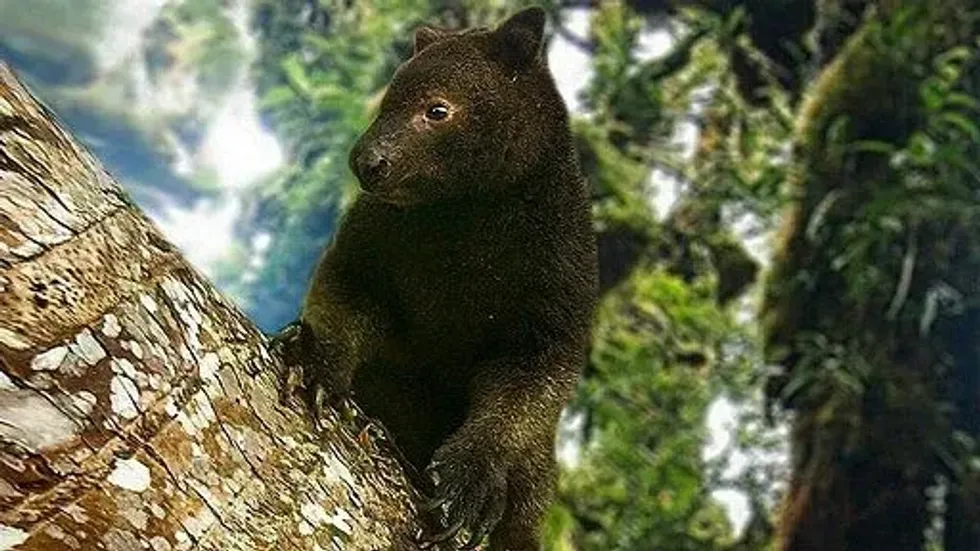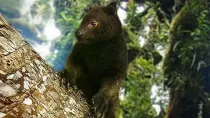A close relative of Doria's tree kangaroo, the tenkile tree kangaroo (Dendrolagus scottae) is endemic to the Torricelli Mountains of Papua New Guinea. The species is also known as Scott's tree kangaroo and sadly, humans are majorly responsible for the decline in the tenkile population.
The tenkile tree kangaroo has a limited habitat and is primarily found in the Torricelli mountain range, the species is found about 2952- 5577 ft (900-1,700 m) above sea level. Tropical and mid-mountain rainforests dominated by trees such as podocarpus, libocedrus, rapanea, and many more serve as a better habitat for this animal.
These tree kangaroos are herbivores and feed on tree leaves, ferns, and soft vines.
Unlike other tree kangaroos, the tenkile is considered an intelligent species. These tree kangaroos are able to raise their arms above their heads and the species has black and dark brown colored limbs and a long tail. They have long snouts and are able to hop and walk bipedally. Tenkile tree kangaroos also possess a powerful and never-ending odor.
The International Union for Conservation of Nature has listed the species in the Critically Endangered category as it is threatened by hunting and a loss of habitat. The species is often hunted for its meat and skin.
Groups such as the Tenkile Conservation Alliance (TCA) have been formed to protect the species and their habitat in the Torricelli mountain range to prevent the species from reaching extinction.
For more relatable content, check out these mongoose facts and marsupial mole facts for kids.
Tenkile Interesting Facts
What type of animal is a tenkile?
The tenkile tree kangaroo (Dendrolagus scottae) is endemic to the Torricelli mountain range of Papua New Guinea. The tenkile tree kangaroo is a herbivore and mainly feeds on tree leaves, ferns, and soft vines. The actions of humans have highly affected the species and the forests it lives in.
What class of animal does a tenkile belong to?
The tenkile tree kangaroo belongs to the class of Mammals, the family of Macropodidae, and the Dendrolagus genus. Species such as the grizzled tree kangaroo, Doria's tree kangaroo, and the dingiso also belong to the Dendrolagus genus.
How many tenkiles are there in the world?
As of October 2006, there were about 200 tenkiles. The population of the tenkile tree kangaroo has been mainly affected by hunting and the species is classified as Critically Endangered by the IUCN.
Where does a tenkile live?
The tenkile tree kangaroo (Dendrolagus scottae) is primarily found in the Torricelli mountain range on the island of Papua New Guinea.
What is a tenkile's habitat?
The tropical and mid-mountain rainforests predominated by trees such as podocarpus, libocedrus, rapanea, and many more serve as the ideal habitat for the tenkile.
Who do tenkiles live with?
Like other tree kangaroos, the tenkile is a solitary animal that prefers to live alone. Hoowever, local landowners report that they have seen small groups of four tenkiles that consist of a male, a female, and their juveniles in the wild. Also, these animals come together during the breeding season.
How long does a tenkile live?
Very little information regarding the average tenkile lifespan is available but tree kangaroos generally live for around 20 years in captivity. If they are not hunted in the wild, their lifespan could even increase.
How do they reproduce?
Very little information regarding the breeding patterns of the tenkile tree kangaroo (Dendrolagus scottae) is available as of now. It is said that both in wildlife and captivity, males generally fight with others in the presence of females.
The tenkile tree kangaroo (Dendrolagus scottae), like other species of Dendrolagus, breeds throughout the year. Females give birth to a baby (joey) after one year and the average litter size is one.
In other tree kangaroo species, the gestation period generally lasts for around 32 days, while the joey remains in the pouch for around 305 days. The baby starts crawling and feeding after 408 days and only the female nurses the joey until it becomes big enough to fend for itself.
Their slow breeding rate may have pushed this species to the verge of extinction.
What is their conservation status?
The International Union for Conservation of Nature has listed the species in the Critically Endangered category and it is threatened by hunting and loss of habitat. The species is hunted for its meat and skin.
Groups such as the Tenkile Conservation Alliance (TCA) have been formed to protect the species and their habitat in the Torricelli mountain range to prevent the species from reaching extinction.
Several tenkile preservation acts have also been passed. A more recent population of tree kangaroos is not known but there were around 2400 individuals left in 2014.
Tenkile Fun Facts
What do tenkiles look like?
They have black and dark brown colored limbs and a long tail. They have long snouts and are able to hop and walk bipedally. Tenkile tree kangaroos also possess a powerful and never-ending odor.
How cute are they?
Tenkile tree kangaroos are considered among the cutest and most intelligent marsupials. Unlike other species, like grizzled tree kangaroos, they are able to raise their arms above their heads. Anyone would love to see their joeys feeding and coming out their pouches too!
How do they communicate?
Like other species of tree kangaroos, tenkiles use diverse methods to communicate. They use their touch, vision, and sense of smell to perceive the environment around them. Also, they possess a powerful and persistent odor that helps them to find their mates.
How big is a tenkile?
The average length of a tenkile is not known but the species weighs around 20-24 lb (9-11 kg). The species is 15 times bigger than the marsupial mole, and tenkiles are even bigger than some species of wallaby.
How fast can a tenkile move?
The exact speed of tenkiles is not currently known as they generally remain aloof in wildlife. It is known that tree kangaroos generally reach a speed of 45 mph (72 kph) while running.
How much does a tenkile weigh?
Tenkile tree kangaroos weigh around 20-24 lb (9-11 kg).
What are their male and female names of the species?
A male kangaroo is known as a 'buck', while the term 'jill' is used for a female kangaroo.
What would you call a baby tenkile?
People often use the term 'joey' to refer to a baby tenkile.
What do they eat?
Tenkile tree kangaroos are herbivores and they generally feed on tree leaves, ferns, and soft vines. Humans have emerged as their major predators, and saving them is becoming quite a difficult task. In Australia, trees kangaroos are often preyed upon by animals like the Australian dingo and the python.
Are they dangerous?
Generally, these endangered animals are solitary and they prefer not to live around humans in forests. Also, it is very hard to find them in wildlife. Tenkile tree kangaroos possess sharp claws and can easily attack humans if they try to provoke or threaten them.
Would they make a good pet?
No, a decline in the population of these animals can be seen, so it is illegal to keep them as pets. They are Critically Endangered.
Also, the Tenkile Conservation Alliance (TCA) group was formed to protect the endangered tenkile and the Torricelli mountain range. You can easily find these beautiful animals in zoos and national parks, and local people living near the Torricelli mountain range region, as well as landowners, are taking steps towards saving the species.
Did you know...
Whilst the tenkile is Critically Endangered, the grizzled tree kangaroo has been listed as Vulnerable in the IUCN Red List.
The tenkile is an arboreal animal which means it spends more time on trees than on land. The dingiso, a species of the same genus, primarily lives on land.
There are 14 species of tree kangaroos in total and there are four Australian species of kangaroos living in Australia currently.
Why are they also known as Scott's tree-kangaroos?
The trust income of the Scott Trust was donated to an Australian Museum Research Program. Participants of this group discovered a population of tenkiles and thus named the species Scott's tree kangaroos in the honor of Scott Winifred, a former member of the Scott Trust.
What adaptations does the tenkile have?
As we know the species is found about 2952- 5577 ft (900-1,700 m) above sea level. The tree kangaroo has developed its body to be able to live on the upper levels of the rainforest and mountains.
The animal possesses great balance and agility skills that help it to jump from one tree to another without falling on the forest floor. Tenkiles have floppy tails and large foreclaws to grasp tree branches easily.
Here at Kidadl, we have carefully created lots of interesting family-friendly animal facts for everyone to discover! Learn more about some other mammals from our gerbil facts or nutria facts pages.
You can even occupy yourself at home by coloring in one of our free printable Tenkile coloring pages.









